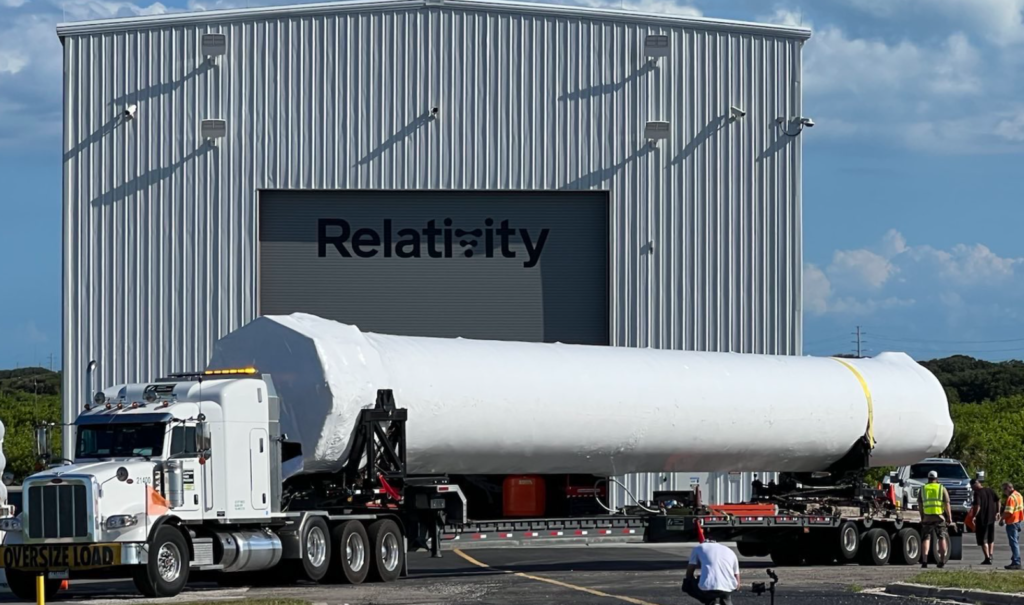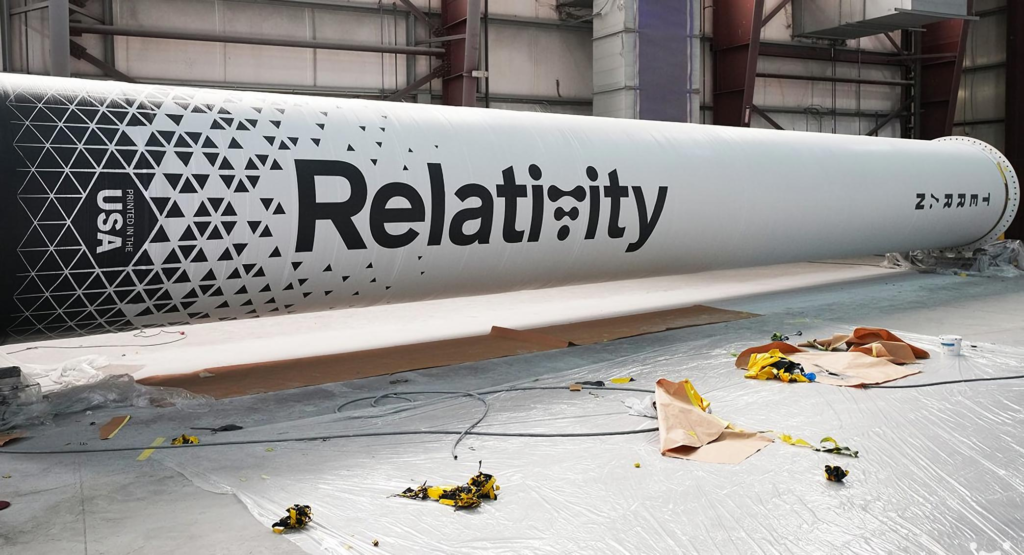
Relativity Space Continues To Make Progress Towards Its First Launch
Another few weeks have passed and so has progress all around the space industry. Now is an especially exciting time to watch a large list of companies and agencies work on new and ambitious projects for the future. Relativity Space is a great example as they are closer than ever to the company’s first ever orbital test flight of Terran 1.
This launch will not only be the first for the company and specific rocket, but also a test of the unique manufacturing process and its ability to cut costs, time, and stay strong throughout a launch. All of which will be put to the test in only a few months from now. Over the past few weeks Relativity along with CEO, Tim Ellis have provided updates on everything Terran 1 prior to the mission.
Rocket Launches are an immensely difficult task that few companies and even agencies around the world have successfully completed. Relativity has high hopes and is confident in its design however this first launch will easily be the biggest challenge yet. Here I will go more in-depth into some of the updates over the past few weeks and when we can expect to see Terran 1 lift off for the first time.
Recent Updates

If you have been keeping up with Relativity Space’s progress you will have watched the company continue to work towards this first Terran 1 launch. For months now Relativity has put practically all its focus into reaching orbit for the first time with this new launch vehicle. Thankfully, they have continued to update us on what specifically they are working on and when we should expect to see a launch. One of the first updates came in the form of a tweet on May 31st saying, “The factory is electric this morning as we prepare to ship Stage 1! Stay tuned for more updates.” This included a short video within the factory showing off the Terran 1 first stage prepared to leave and a massive crowd of Relativity Space employees and more. The next day on June 1st, Relativity tweeted again this time mentioning, “Stage 1 is officially making its way to Cape Canaveral, Florida, where #Terran1 will launch! Check out these photos of Stage 1 being loaded onto the truck and headed to the #sunshinestate.” This obviously is a very big moment for the company as they have tested the stage and are now preparing for the launch itself at Launch Complex 16 in Flordia. As the stage traveled across the United States CEO Tim Ellis showed us its progress with a tweet on June 2nd that said, “gm from Arizona”. After a multiple day journey, Tim Ellis tweeted again pointing out, “Carrier has arrived! Terran 1, welcome to Cape Canaveral. Can’t wait to take you for a spin.” Finally, just yesterday Relativity announced that the Terran 1 Mission Page was live as they near the launch of the rocket.
Practically all of what I just mentioned has taken place in only the past two weeks. This helps put in perspective how much work Relativity is putting into this launch and the speed at which they are doing it. As of right now both stages of Terran 1 have been tested and are at Cape Canaveral. This means there are only a few final steps necessary before the long-awaited launch takes place.
Terran 1 & Launch Date

Now that we know more about Relativity’s progress and what Terran 1 has been up to, we can take a closer look at when we should expect this launch to happen and why this launch vehicle is so important. In terms of a launch date, over the past few years it has been pushed back quite a few times. What was originally expected to happen in 2021, was later delayed to early 2022. While Relativity has not yet provided an exact date for the upcoming launch, they have said it’s expected to happen in the summer of 2022 or only a few months from now. As mentioned prior, with both stages already tested and now delivered to Cape Canaveral, the company is very close to launching. We can expect to see Terran 1 lift off in a few months if everything goes perfect and towards the end of the year if we are being the most realistic.
Once ready, this historic launch will take place from Launch Complex 16. Before Relativity was competitively awarded the site in 2019, LC-16 was used by the US Air Force for Titan I, Titan II, and Pershing missile launches, and briefly by NASA for Gemini crew processing and static test firing of the Apollo Service Module’s propulsion engine. After being awarded the site, Relativity have worked to construct a simple yet effective site capable of supporting Terran 1. The site features a Launch Pad, Propellant Farms and Gas Storage, Integration Hangar & Logistics Area, Payload Processing Facility (PPF), and Launch Control Center (LCC). LC-16 will support initial test flights of Terran 1 and subsequent customer flights. The launch site, on the eastern end of Cape Canaveral Air Force Station at is ideal for supporting low- to mid-inclination (28.5° to 55°) orbits. Inclinations less than 28° and greater than 55° are also possible but may result in decreased mass to orbit performance due to dogleg trajectories. In relation to this launch site and its construction, just over a week ago on June 2nd, Relativity tweeted saying, “#ThrowbackThursday to when we rolled our strongback from the launchpad at Cape Canaveral, FL, into the hangar for the first time to verify system ability and overall operability and geometry.”
Relativity is scheduled for its first launch of Terran 1, called “GLHF” (Good Luck, Have Fun), from Launch Complex 16 (LC-16) in Cape Canaveral in summer 2022. This launch of Terran 1 is the first orbital attempt by Relativity and will not include a customer payload. As a two-stage, 110ft. tall, 7.5 ft. wide, expendable rocket, Terran 1 is the largest 3D printed object to exist and to attempt orbital flight. Working towards its goal of being 95% 3D printed, Relativity’s first Terran 1 vehicle is 85% 3D printed by mass. Terran 1 has nine Aeon engines on its first stage, and one Aeon Vac on its second stage. Like its structure, all Relativity engines are entirely 3D printed, and use liquid oxygen (LOX) and liquid natural gas (LNG), which are not only the best for rocket propulsion, but also for reusability, and the easiest to eventually transition to methane on Mars. As one of the few LOX/LNG fueled rockets in the industry, Terran 1 is racing to be the first LOX/LNG rocket to fly.
Relativity believes in a future where interplanetary life fundamentally expands the possibilities for human experience. In realizing this audacious vision, the company’s long-term goal is to upgrade humanity’s industrial base on Earth and on Mars. They believe in a more inspired future with people thriving on Earth and on Mars. In the early days of settlement, intelligent automation and lightweight, compact 3D printing are fundamental technologies needed to quickly establish a new society with scarce resources. This first launch will play an important role in Relativity’s future and what they plan to achieve.
In addition, the company often points out that for 60 years, aerospace manufacturing has relied on large factories, fixed tooling, complex supply chains, and extensive manual labor to build costly rockets comprised of 100,000+ parts in 2 years or longer. In order to accelerate innovation in the industry, Relativity built its Factory of the Future, the first aerospace platform to automate rocket manufacturing, vertically integrating intelligent robotics, software, and data-driven 3D printing technology. Incorporating Stargate, the world’s largest metal 3D printer with AI-driven controls, Relativity’s Factory of the Future works to continuously optimize production, resulting in greatly compounded quality and time improvements, lower costs, and product designs previously not possible. Relativity is an application-layer 3D printing company that is starting with rockets, and will extend its Factory of the Future to all of aerospace. As a next generation launch vehicle, Terran 1 is designed for the future of constellation deployment and resupply. Its unique and software-driven architecture is capable of accommodating satellite customers’ evolving needs, while also providing the most agile and affordable launch service on the market. Designed and printed in the USA, Relativity is confident that Terran 1 is the most innovative product to emerge from the aerospace manufacturing industry since the dawn of privatization of space 20 years ago. This launch will also put the Aeon engines to the test. Relativity’s engines, Aeon 1, Aeon R, and Aeon Vac, are 3D-printed, enhancing mission reliability by reducing part count in engine combustion chambers, igniters, turbopumps, reaction control thrusters, and vehicle pressurization systems. All of which will be put to the test not long from now.
Conclusion
Relativity space is one of many companies within the space industry working towards the first launch of a new rocket. While an exciting process, it is also very stressful as the company tries to prepare for an extremely violent and complex launch. This being said, over the past few months we have watched Relativity work hard to prepare and set up for this historic mission. We will have to wait and see how it progresses and the impact it has on the space industry.
